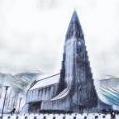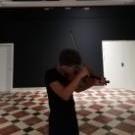Leaderboard
Popular Content
Showing content with the highest reputation on 01/17/2023 in all areas
-
Hi, here's the complete sonata of which I posted the first movement a few months ago... I would be very grateful for your feedback!1 point
-
A symbolist piece, recently finished, now time to see if it needs a few touch ups. Modern but not atonal. I'm trying to put a suite together of similar styled pieces. This would likely be one of the middle movements. If you have time to spare please give it a hearing and make any comments or suggestions you like - always gratefully received - including to the score. There's one discrepancy between score and audio: I originally wrote a part for bass flute but transferred it in the score to the bass clarinet.1 point
-
A TV show intro theme I composed inspired by Star Trek, Stargate, and the other usual Star suspects. Let me know what you think of it!1 point
-
Very good points, haha. I found this, and it seems it needs to be transposed: I am not sure how much more difficult this would be with the revisions. @Thatguy v2.0 kindly informed me that a player needs at least 7 seconds to change instruments and that they should not enter in an extreme register, and I tried to adhere to that. If anyone has any other rules of thumb, please let me know!1 point
-
Hey I see your new score! I see this score is in the actual pitch. I am not sure whether it's a must to notate the score in transpoed score and will it be difficult for the players to play though😅. Henry1 point
-
Hi @Henry Ng Tsz Kiu, you've been so generous with you constructive comments on my music that now I feel inadequate commenting on yours! Oh, well. I like the pastorale sound of the movement. It is reminiscent of the 6th symphony, of course, beyond the thematic similarity, but it also reminds me of certain bits of the pastorale piano sonata (eg bars 56-57 and similar passages), which I guess means you have captured the "pastorale" atmosphere right on! I only have two observations. One is at 33-34 and 133-34: why do you leave the melody unaccompanied in the right hand? I thought that adding chords in the tenor/alto registry would be a nice addition. Second is at bar 95-103: do you think it'd be interesting to try and amplify the tension building for instance by starting with the left hand playing quaver chords at 95-96, then 8th broken chords at 97-98, then 16th etc.? or would that be too crass? I like the development section a lot (might also be closest to the symphony in parts) and in general I'm a big fan of how natural and beautiful your harmonic progressions sound. Thank you! Is there any way we could listen to the remaining movements?1 point
-
The Universe Messiaen is very big. He described several sacale-modes using repetition of interval groups (symmetry). The modes can be transposed chromatically a limited number of times, because the procedure reaches a point where the scale repeats itself enharmonically. The 4th mode has this pattern ST - ST - ST+T - ST - ST - ST - ST+T It is octatonic That is: C - Db - D - F - F# - G - Ab - B You can transpose this mode starting on Db, D, Eb, E and F. So, 6 transpositions (counting on C) Because starting on F# it is enharmonic: F# - G - Ab - B - C - Db - D You can use it harmonically, melodically, polyphonically.... You can make chords that resemble tonal functionality or use it as a mode without tonal center... The transformations you can do with Messiaen modes are endless. He described 7 modes of limited transposition.1 point
-
Found the solution. You have to hold down the control key when you drag a new key signature onto the score. That way it only changes the key signature of one instrument, rather than the whole piece.1 point
-
Yes you got it! I enjoy the theme played by the cello, as it provides a contrast of register! And I find that the dynamic markings are much more detailed now! Good job! Henry1 point
-
I got it (I think) and added a variation with the theme played by the cello. Check it out if you have time (it is now var. 2)1 point
-
I have nothing critical to say! I enjoy the somewhat pointillistic nature of the piece. Very refreshing harmonic colour for me, and nice use of sparse texture and phrase structure. The atmosphere for me is very unsettling which I like. I love your usage of having the solo instruments sing for themselves and each of their timbre is very prominent. I love the glissandos of the strings! I think sul ponticello can be added to some of the high register passages of the violin but that's subjective. Very enjoyable and thanks for sharing! Henry1 point
-
Hello Quinn! This piece is so full of character and even desperation. I can definitely feel the heat, and I was hooked from the opening. There is so little I would change about this, but I saw that you wanted to touch up the dynamics. At 2:32 I personally feel that the brass passage could be louder to build momentum. From 2:00 I feel this sense of teasing that I really like. First the piccolo and flute crescendo and give way to quiet again, then the strings, then the clarinet, and finally the brass. But, for me, the effectiveness of that dynamic pattern was starting to wear off by the entry of the brass, which could maybe benefit from starting at forte instead of mezzo forte. I am also wondering if the preceding English horn solo may be breaking up the momentum a bit as it is very thin and exposed compared to the music surrounding it? I would consider adding accompaniment. Of course, others may feel much differently and that was really the only time in the piece that I found my attention starting to wander. You created tension very well otherwise! 🙂 I look forward to hearing your additions to the Suite, and I hope they are as immersive and visceral as this! ~ Gwendolyn P.S. I love your harp and vibraphone sounds. What sample library did you use, if you don't mind my asking?1 point
-
1/16/23 UPDATE: I've revised the piece for quintet and modified both the score and SoundCloud track. I would love to hear any feedback! I hope that I correctly notated the switches between flute and piccolo and between oboe and English horn, as this is my first time writing for more than one instrument per player. ~ Gwendolyn1 point
-
OK, I took you at your word. I worked on that motif. This is a little development with the initial exposition, and two contrasting parts. Several textures and basic techniques (inversion, retrogadation, etc....). All based on Messiaen's 4th mode.1 point
-
Intriguing source material to say the least. It's always fun to see how different composers are inspired! I'm sure you have made 5 tuba players somewhere very happy. It doesn't seem like they get much solo material, and here they have 4 minutes of uninterrupted bliss. (NOTE: If you could be ever so kind as to post a PDF of the score so reviewers don't have to follow along on YT (such a pain to navigate back to when writing reviews), that would be much appreciated!!) Now, let's talk about the music. The aleatoric sections that bookend the piece are a risky choice and not one that adds much value to the listener's/reviewer's experience in my opinion. I feel that such a choice requires justification, as the rest of the piece flows in a more traditional manner. If it's just to "shake things up," that's well and good; there are other ways of doing that without a clashing of musical styles. We also should consider the enjoyment of tubas 4 and 5, who are relegated to playing repetitive quarter notes with rare departures to other note species. I find myself asking if removing them from the piece would significantly alter the message, and I feel the answer is "no." The bass drum provides us with a driving rhythm (and will probably drown out their parts, anyway), and even when these lower tuba parts don't echo the drum's rhythm, they copy a higher tuba's part in octave. I suppose my point is that you could likely achieve the same—or nearly the same—effect by completely removing those 2 parts. I did enjoy the minor rendition of Kyrie Elaison, especially the contrary harmonic motion between the 1st tuba and the others. Counterpoint was sparse but it was there, so kudos for that! The articulations, however, were overdone. I think the piece would've sounded roughly the same if even 75% of the written articulations were omitted. Also problematic is the passage beginning at M79, where you have the tubas play, in unison, a D1 at a dynamic of ffff. And have them hold it for a whole note. With an accented articulation. In tubas 4 and 5, this is followed shortly after by a series of low, loud, and long dotted half notes. I'm not doubting the physical possibility of this, just that of your players. And why risk it? If you want loudness (or the illlusion of loudness, which is often just as effective), try breaking that unisoned D up into a chord (a nondiatonic one for extra points). The sound is spread out over a wider range of frequencies and the assault on the eardrums more pronounced. All in all, I think this piece has great promise. I enjoy the choice of instrumentation and find the source material unique. If you wanted to sink some extra time into this work to clean up the articulations and "fatten" out the partwriting, this piece would really shine! Best, Jörfi1 point
-
Maybe I will just try what Haydn did in his Emperor Quartet: Just transfer the melody to viola/cello! The registeral change of the melody will provide great contrast. In that quartet Haydn gave the theme to each member of the quartet and each takes turn to accompany them, finally ends with the melody return to 1st violin. A device as "simple" as going up an octave in the final variation creates tremendous effect! Yoi can check this out! Henry1 point
-
@Henry Ng Tsz Kiu I totally missed this! Thank you (again!) for your careful listening and nice comments. I'm going to try and implement your suggestions, because I think they would improve the piece quite a lot! I'm going to work on better connecting the mid-section with the rest of the second movement, and on the third movement (fill last quaver sounds right, as is the movement feels a bit to jerky; also b sharp minor actually now that you name it sounds weird, maybe I'll change it into c minor!). As for the variations, I'm gonna think if there's a way to incorporate a cello- or viola-based variation without making the movement too long. Thank you again!!1 point
-
I am glad you enjoyed it @ComposedBySam. Thank you for your words1 point
-
1 point
-
Thank you for your commentary - you are most kind. I thought I needed to make a couple of changes - prune it down for a start but if it seems ok length-wise it'll just be a few touch-ups to the dynamics and perhaps instrument assignments. Like I said it's a symbolist piece that relies on motifs and mood and it's consoling to learn that this once at least it seems to portray the intended mood. Again, many thanks. Much appreciated. And MFOBOE... I'm not up on these cinematic styles so I'll have to take your word for it! Thank you for your comments all the same.1 point
-
Wow, how did I miss this one! Wonderful piece, extraordinary color and very idiomatic. I could picture hopelessness in the desert, or perhaps traveling to Europe during it's heat wave right now....bad joke. I really enjoyed your modern use of the orchestra. The sparse texture really allowed for you to color this one beautifully. If I had any critique, it would be that I didn't have much to latch on to. Surely that's personal preference, and yes I was aware of your themes that you dispersed throughout, but it was more of a barrage of color rather than a story to follow. Maybe it would depend on your other movements in the suite, but as an abstract portrayal of the fire in the sky, it definitely works. I'm curious, was that your intent? All in all, I'm glad I stumbled upon this work of yours. You're always someone I look out for for new music. Brilliant work, and thanks for sharing! Keep us updated as you arrange your different pieces for your suite; I'd like to listen to them in the order you intend.1 point
-
There isn't a thing about this I don't like! The orchestral colors you employ here are indeed an eponymous warm and flaring. The rhythmic texture is breathtaking: organic and wild, yet with just enough of a foothold exposed that we aren't taken for a tumble down the melodic mountainside. I particularly enjoyed the harmonic language that relied so much on quartal chords. It really flavors the music with a richer, broader, and perhaps sharper contour. Thoroughly modern, as you said. Fantastic music! I look forward to the prequels and sequels.1 point







